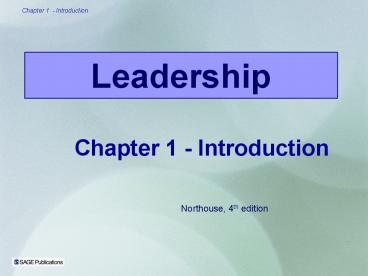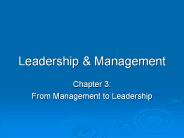Leadership - PowerPoint PPT Presentation
1 / 18
Title:
Leadership
Description:
Leadership Definition. Components of the Definition. Followers & Leadership ... The process definition of Leadership: LEADER. Leadership (Interaction) FOLLOWERS ... – PowerPoint PPT presentation
Number of Views:233
Avg rating:3.0/5.0
Title: Leadership
1
Leadership
Chapter 1 - Introduction
Northouse, 4th edition
2
Overview
- Conceptualizing Leadership
- Leadership Definition
- Components of the Definition
- Followers Leadership
3
Conceptualizing Leadership
Some definitions view leadership as
- The focus of group processes
- A personality perspective
- An act or behavior
- In terms of the power relationship between
leaders followers - An instrument of goal achievement
- A skills perspective
4
Leadership Defined
- Leadership
- is a process whereby an individual influences a
group of individuals to achieve a common goal.
5
Components Central to the Phenomenon of
Leadership
Leadership
- Is a process
- Involves influence
- Occurs within a group context
- Involves goal attainment
Leaders
- Are not above followers
- Are not better than followers
- Rather, an interactive relationship with
followers
6
LEADERSHIPDESCRIBED
- Trait vs. Process Leadership
- Assigned vs. Emergent Leadership
- Leadership Power
- Leadership Coercion
- Leadership Management
7
Trait vs. Process Leadership
Trait definition of leadership
- Certain individuals have special innate or inborn
characteristics or qualities that differentiate
them from nonleaders. - Resides in select people
- Restricted to those with inborn talent
LEADER
- Height
- Intelligence
- Extroversion
- Fluency
- Other Traits
Leadership
FOLLOWERS
8
Trait vs. Process Leadership
The process definition of Leadership
- Leadership is a property or set of properties
possessed in varying degrees by different people
(Jago, 1982). - Observed in leadership behaviors
- Can be learned
LEADER
Leadership
(Interaction)
FOLLOWERS
9
Assigned vs. Emergent Leadership
Assigned
Emergent
- Leadership based on occupying a position within
an organization - Team leaders
- Plant managers
- Department heads
- Directors
- An individual perceived by others as the most
influential member of a group or organization
regardless of the individuals title - Emerges over time through communication behaviors
- Verbal involvement
- Being informed
- Seek others opinions
- Being firm but not rigid
10
Leadership Power
Bases of Social Power French Raven (1959)
Power
- The capacity or potential to influence.
- Ability to affect others beliefs, attitudes
actions
- Referent
- Expert
- Legitimate
- Reward
- Coercive
Power is a relational concern for both leaders
and followers.
11
Leadership Power
- Five Bases of Power
12
Leadership Power
- Five Bases of Power
- REFERENT POWER Based on followers
identification and liking for the leader. - ex. A schoolteacher who is adored by her students
has referent power. - EXPERT POWER Based on followers perceptions of
the leaders competence. - ex. A tour guide who is knowledgeable about a
foreign country has expert power. - LEGITIMATE POWER Associated with having status
or formal job authority. - ex. A judge who administers sentences in the
courtroom exhibits legitimate power
13
Leadership Power
- Five Bases of Power
- REWARD POWER Derived from having the capacity
to provide rewards to others. - ex. A supervisor who gives rewards to employees
who work hard is using reward power. - COERCIVE POWER Derived from having the capacity
to penalize or punish others. - ex. A coach who sits players on the bench for
being late to practice is using coercive power.
14
Leadership Power
Types and Bases of Power
Position Power
Personal Power
- Power is influence derived from being seen as
likable knowledgeable - Referent
- Expert
- Power derived from office or rank in an
organization - Legitimate
- Reward
- Coercive
15
Leadership Coercion
Coercion Involves
Examples of Coercive Leaders
- Use of force to effect change
- Influencing others to do something via
manipulation of rewards and penalties in the work
environment - Use of threats, punishments, negative rewards
- Adolf Hitler
- Jim Jones
- David Koresh
Power restraint used to force followers
to engage in extreme behavior
16
Leadership Management Kotter (1990)
Management Activities
Leadership Activities
Produces order and consistency
Produces change and movement
- Planning Budgeting
- Organizing Staffing
- Controlling Problem Solving
- Establishing direction
- Aligning people
- Motivating / Inspiring
Major activities of management leadership are
played out differently BUT, both are
essential for an organization to prosper.
17
Leadership Management Kotter (1990)
Major activities of management and leadership are
played out differently BUT, both are essential
for an organization to prosper.
18
Leadership ManagementZaleznik (1977)
Managers Unidirectional Authority
Leaders Multidirectional Influence
- Are emotionally active
- involved
- Are reactive
- Shape ideas over
- responding to them
- Prefer to work with
- people on problem
- solving
- Act to expand
- available options
- Low emotional
- involvement
- Change the way people
- think about what is
- possible































